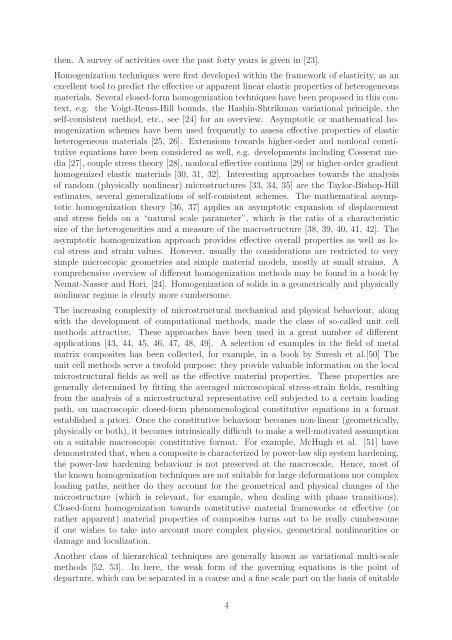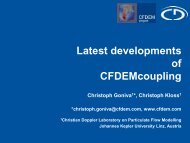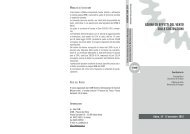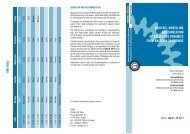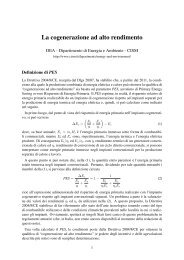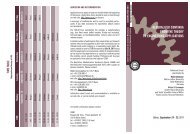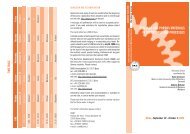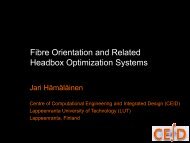Scale transitions in solid mechanics based on computational ... - Cism
Scale transitions in solid mechanics based on computational ... - Cism
Scale transitions in solid mechanics based on computational ... - Cism
- No tags were found...
You also want an ePaper? Increase the reach of your titles
YUMPU automatically turns print PDFs into web optimized ePapers that Google loves.
then. A survey of activities over the past forty years is given <str<strong>on</strong>g>in</str<strong>on</strong>g> [23].Homogenizati<strong>on</strong> techniques were first developed with<str<strong>on</strong>g>in</str<strong>on</strong>g> the framework of elasticity, as anexcellent tool to predict the effective or apparent l<str<strong>on</strong>g>in</str<strong>on</strong>g>ear elastic properties of heterogeneousmaterials. Several closed-form homogenizati<strong>on</strong> techniques have been proposed <str<strong>on</strong>g>in</str<strong>on</strong>g> this c<strong>on</strong>text,e.g. the Voigt-Reuss-Hill bounds, the Hash<str<strong>on</strong>g>in</str<strong>on</strong>g>-Shtrikman variati<strong>on</strong>al pr<str<strong>on</strong>g>in</str<strong>on</strong>g>ciple, theself-c<strong>on</strong>sistent method, etc., see [24] for an overview. Asymptotic or mathematical homogenizati<strong>on</strong>schemes have been used frequently to assess effective properties of elasticheterogeneous materials [25, 26]. Extensi<strong>on</strong>s towards higher-order and n<strong>on</strong>local c<strong>on</strong>stitutiveequati<strong>on</strong>s have been c<strong>on</strong>sidered as well, e.g. developments <str<strong>on</strong>g>in</str<strong>on</strong>g>clud<str<strong>on</strong>g>in</str<strong>on</strong>g>g Cosserat media[27], couple stress theory [28], n<strong>on</strong>local effective c<strong>on</strong>t<str<strong>on</strong>g>in</str<strong>on</strong>g>ua [29] or higher-order gradienthomogenized elastic materials [30, 31, 32]. Interest<str<strong>on</strong>g>in</str<strong>on</strong>g>g approaches towards the analysisof random (physically n<strong>on</strong>l<str<strong>on</strong>g>in</str<strong>on</strong>g>ear) microstructures [33, 34, 35] are the Taylor-Bishop-Hillestimates, several generalizati<strong>on</strong>s of self-c<strong>on</strong>sistent schemes. The mathematical asymptotichomogenizati<strong>on</strong> theory [36, 37] applies an asymptotic expansi<strong>on</strong> of displacementand stress fields <strong>on</strong> a “natural scale parameter”, which is the ratio of a characteristicsize of the heterogeneities and a measure of the macrostructure [38, 39, 40, 41, 42]. Theasymptotic homogenizati<strong>on</strong> approach provides effective overall properties as well as localstress and stra<str<strong>on</strong>g>in</str<strong>on</strong>g> values. However, usually the c<strong>on</strong>siderati<strong>on</strong>s are restricted to verysimple microscopic geometries and simple material models, mostly at small stra<str<strong>on</strong>g>in</str<strong>on</strong>g>s. Acomprehensive overview of different homogenizati<strong>on</strong> methods may be found <str<strong>on</strong>g>in</str<strong>on</strong>g> a book byNemat-Nasser and Hori. [24]. Homogenizati<strong>on</strong> of <str<strong>on</strong>g>solid</str<strong>on</strong>g>s <str<strong>on</strong>g>in</str<strong>on</strong>g> a geometrically and physicallyn<strong>on</strong>l<str<strong>on</strong>g>in</str<strong>on</strong>g>ear regime is clearly more cumbersome.The <str<strong>on</strong>g>in</str<strong>on</strong>g>creas<str<strong>on</strong>g>in</str<strong>on</strong>g>g complexity of microstructural mechanical and physical behaviour, al<strong>on</strong>gwith the development of computati<strong>on</strong>al methods, made the class of so-called unit cellmethods attractive. These approaches have been used <str<strong>on</strong>g>in</str<strong>on</strong>g> a great number of differentapplicati<strong>on</strong>s [43, 44, 45, 46, 47, 48, 49]. A selecti<strong>on</strong> of examples <str<strong>on</strong>g>in</str<strong>on</strong>g> the field of metalmatrix composites has been collected, for example, <str<strong>on</strong>g>in</str<strong>on</strong>g> a book by Suresh et al.[50] Theunit cell methods serve a twofold purpose: they provide valuable <str<strong>on</strong>g>in</str<strong>on</strong>g>formati<strong>on</strong> <strong>on</strong> the localmicrostructural fields as well as the effective material properties. These properties aregenerally determ<str<strong>on</strong>g>in</str<strong>on</strong>g>ed by fitt<str<strong>on</strong>g>in</str<strong>on</strong>g>g the averaged microscopical stress-stra<str<strong>on</strong>g>in</str<strong>on</strong>g> fields, result<str<strong>on</strong>g>in</str<strong>on</strong>g>gfrom the analysis of a microstructural representative cell subjected to a certa<str<strong>on</strong>g>in</str<strong>on</strong>g> load<str<strong>on</strong>g>in</str<strong>on</strong>g>gpath, <strong>on</strong> macroscopic closed-form phenomenological c<strong>on</strong>stitutive equati<strong>on</strong>s <str<strong>on</strong>g>in</str<strong>on</strong>g> a formatestablished a priori. Once the c<strong>on</strong>stitutive behaviour becomes n<strong>on</strong>-l<str<strong>on</strong>g>in</str<strong>on</strong>g>ear (geometrically,physically or both), it becomes <str<strong>on</strong>g>in</str<strong>on</strong>g>tr<str<strong>on</strong>g>in</str<strong>on</strong>g>sically difficult to make a well-motivated assumpti<strong>on</strong><strong>on</strong> a suitable macroscopic c<strong>on</strong>stitutive format. For example, McHugh et al. [51] havedem<strong>on</strong>strated that, when a composite is characterized by power-law slip system harden<str<strong>on</strong>g>in</str<strong>on</strong>g>g,the power-law harden<str<strong>on</strong>g>in</str<strong>on</strong>g>g behaviour is not preserved at the macroscale. Hence, most ofthe known homogenizati<strong>on</strong> techniques are not suitable for large deformati<strong>on</strong>s nor complexload<str<strong>on</strong>g>in</str<strong>on</strong>g>g paths, neither do they account for the geometrical and physical changes of themicrostructure (which is relevant, for example, when deal<str<strong>on</strong>g>in</str<strong>on</strong>g>g with phase <str<strong>on</strong>g>transiti<strong>on</strong>s</str<strong>on</strong>g>).Closed-form homogenizati<strong>on</strong> towards c<strong>on</strong>stitutive material frameworks or effective (orrather apparent) material properties of composites turns out to be really cumbersomeif <strong>on</strong>e wishes to take <str<strong>on</strong>g>in</str<strong>on</strong>g>to account more complex physics, geometrical n<strong>on</strong>l<str<strong>on</strong>g>in</str<strong>on</strong>g>earities ordamage and localizati<strong>on</strong>.Another class of hierarchical techniques are generally known as variati<strong>on</strong>al multi-scalemethods [52, 53]. In here, the weak form of the govern<str<strong>on</strong>g>in</str<strong>on</strong>g>g equati<strong>on</strong>s is the po<str<strong>on</strong>g>in</str<strong>on</strong>g>t ofdeparture, which can be separated <str<strong>on</strong>g>in</str<strong>on</strong>g> a coarse and a f<str<strong>on</strong>g>in</str<strong>on</strong>g>e scale part <strong>on</strong> the basis of suitable4


